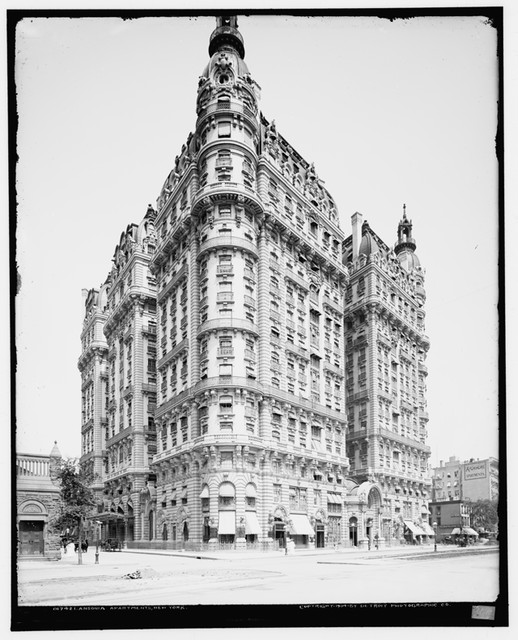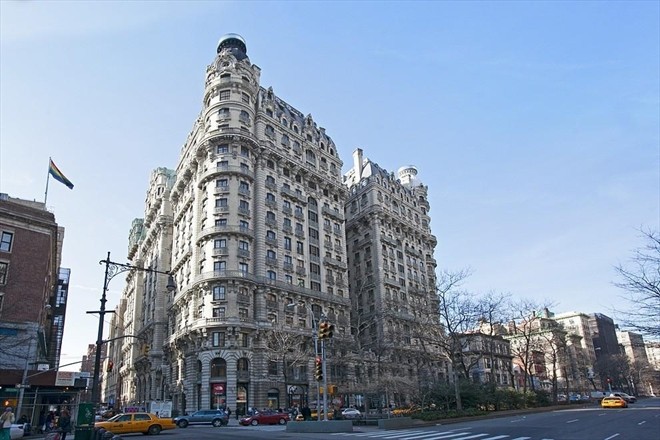The Ansonia
Introduction
Text-to-speech Audio
The lavish residential hotel the Ansonia was the creation of William Earl Dodge Stokes, whose mother was heiress to the Ansonia mining fortune. A flamboyant and controversial entrepreneur, Stokes envisioned Broadway--then known as the Grand Boulevard--as the major commercial and cultural thoroughfare that it would become, and set about building a grand building on the West Side. The result, the Ansonia, was completed in 1899, and soon developed a reputation as flashy and unconventional as that of its owner. In the late twentieth century, the building fell into a marked state of disrepair before it was turned into condominiums in 1990. The Ansonia is a New York City Landmark and is also listed on the National Register of Historic Places.
Images
The Ansonia around the time it was built

The Ansonia today

The Ansonia's interior

William Earl Dodge Stokes

Backstory and Context
Text-to-speech Audio
One of the Upper West Side's most well-known buildings, the Ansonia was the work of William Earl Dodge Stokes, one of nine children of Caroline Phelps, heiress to the Ansonia copper mine fortune, and James Stokes, a banker. Stokes was--without question--the Black sheep of the family, whose flamboyant personality and disregard for society's conventions would persist throughout his life.
Stokes was, if nothing else, a shrewd and forward-thinking businessman. He was one of the earliest Manhattan businessmen to envision Broadway--then known as the Grand Boulevard--as an up-and-coming thoroughfare that would eventually eclipse 5th Avenue, and persuaded the city to pave the Boulevard in 1889, when dirt streets were still the norm.
In the late 1800s, when the Upper West Side was far from a desirable location, Stokes began buying brownstones as well as parcels of land that once belonged to the New York Orphan Asylum. Stokes listed himself as architect in chief when he filed plans with the city for the building he planned to be the most luxurious residential hotel in the city, with amenities that no other property offered. The Ansonia opened in 1904.
In addition to being a luxury dwelling, Stokes also had something of a Utopian vision for the Ansonia; he wanted it to be as self-sufficient as possible, and to that end, a rooftop "farm" was created. The farm included not only produce, but 500 chickens, ducks, goats, and reportedly, a small bear. Until the farm was shut down by the health department, residents at the Ansonia received free fresh eggs, delivered by bellhops, every day.
In addition to fresh eggs, the Ansonia also provided its residents with every conceivable luxury. They lived in opulent apartments, with libraries and parlors and meals prepared by gourmet chefs. The building was also outfitted with what was then a highly advanced system of delivering messages--an elaborate system of pneumatic tubes winding throughout the building.
The Ansonia garnered its share of scandal over the years. In 1919, members of the Chicago White Sox gathered at the hotel and made plans to intentionally lose the 1919 World Series. Florenz Zeigfeld lived with his wife in an apartment in the Ansonia, but also kept his mistress on another floor in the building.
Following the death of Stokes, ownership of the Ansonia passed to his son, Weddie Stokes, who sold it to Samuel Broxmeyer in 1945. Broxmeyer lost the property and it was eventually sold at bankruptcy auction to Jake Starr. Under Starr's ownership, the Ansonia declined and fell into disrepair. The intervention of its residents saved it from being demolished in the 1960s. But the formerly luxurious hotel had Turkish baths and an enormous swimming pool (reportedly the world's largest at the time) in the basement, which Starr rented to Steve Ostrow, who turned them into opulent gay baths. The Continental Baths, as it was known, featured a young Bette Midler (then known as "Bathhouse Betty") and her accompanist, Barry Manilow. The entertainment at the Continental Baths became so popular that lines stretched down the block on the weekend. Eventually, when the Continental Baths's gay patrons began to move to other bathhouses that were less of a spectacle, a swinger's club, Plato's Retreat, opened in the basement. The rest of the building continued to decline, and the once grand building came to be seen as another sleazy New York City hotel.
The Ansonia's long decline was finally halted in 1978 when Jesse Krasnow purchased the building. Krasnow headed a group of 22 investors who began the long and costly process of restoring the Ansonia. It was no small task; Krasnow poured $21 million into the restoration of the building, including $1 million paid to the owner of Plato's Retreat simply to get them to leave. Not all of the tenants were happy with Krasnow, and the 1980s were marked by suits, counter-suits, and rent strikes. The Ansonia is reportedly the most litigated residence in the history of New York City.
But the building, which is listed on the National Register of Historic Places and is also a New York City Landmark, has finally been restored to something close to its original glory. It now attracts celebrities such as Natalie Portman and Angelina Jolie and a condominium in the building is worth millions.
Stokes was, if nothing else, a shrewd and forward-thinking businessman. He was one of the earliest Manhattan businessmen to envision Broadway--then known as the Grand Boulevard--as an up-and-coming thoroughfare that would eventually eclipse 5th Avenue, and persuaded the city to pave the Boulevard in 1889, when dirt streets were still the norm.
In the late 1800s, when the Upper West Side was far from a desirable location, Stokes began buying brownstones as well as parcels of land that once belonged to the New York Orphan Asylum. Stokes listed himself as architect in chief when he filed plans with the city for the building he planned to be the most luxurious residential hotel in the city, with amenities that no other property offered. The Ansonia opened in 1904.
In addition to being a luxury dwelling, Stokes also had something of a Utopian vision for the Ansonia; he wanted it to be as self-sufficient as possible, and to that end, a rooftop "farm" was created. The farm included not only produce, but 500 chickens, ducks, goats, and reportedly, a small bear. Until the farm was shut down by the health department, residents at the Ansonia received free fresh eggs, delivered by bellhops, every day.
In addition to fresh eggs, the Ansonia also provided its residents with every conceivable luxury. They lived in opulent apartments, with libraries and parlors and meals prepared by gourmet chefs. The building was also outfitted with what was then a highly advanced system of delivering messages--an elaborate system of pneumatic tubes winding throughout the building.
The Ansonia garnered its share of scandal over the years. In 1919, members of the Chicago White Sox gathered at the hotel and made plans to intentionally lose the 1919 World Series. Florenz Zeigfeld lived with his wife in an apartment in the Ansonia, but also kept his mistress on another floor in the building.
Following the death of Stokes, ownership of the Ansonia passed to his son, Weddie Stokes, who sold it to Samuel Broxmeyer in 1945. Broxmeyer lost the property and it was eventually sold at bankruptcy auction to Jake Starr. Under Starr's ownership, the Ansonia declined and fell into disrepair. The intervention of its residents saved it from being demolished in the 1960s. But the formerly luxurious hotel had Turkish baths and an enormous swimming pool (reportedly the world's largest at the time) in the basement, which Starr rented to Steve Ostrow, who turned them into opulent gay baths. The Continental Baths, as it was known, featured a young Bette Midler (then known as "Bathhouse Betty") and her accompanist, Barry Manilow. The entertainment at the Continental Baths became so popular that lines stretched down the block on the weekend. Eventually, when the Continental Baths's gay patrons began to move to other bathhouses that were less of a spectacle, a swinger's club, Plato's Retreat, opened in the basement. The rest of the building continued to decline, and the once grand building came to be seen as another sleazy New York City hotel.
The Ansonia's long decline was finally halted in 1978 when Jesse Krasnow purchased the building. Krasnow headed a group of 22 investors who began the long and costly process of restoring the Ansonia. It was no small task; Krasnow poured $21 million into the restoration of the building, including $1 million paid to the owner of Plato's Retreat simply to get them to leave. Not all of the tenants were happy with Krasnow, and the 1980s were marked by suits, counter-suits, and rent strikes. The Ansonia is reportedly the most litigated residence in the history of New York City.
But the building, which is listed on the National Register of Historic Places and is also a New York City Landmark, has finally been restored to something close to its original glory. It now attracts celebrities such as Natalie Portman and Angelina Jolie and a condominium in the building is worth millions.
Sources
Gaines, Steven. The Building of the Upper West Side. New York Magazine. May 06, 2005. Accessed April 21, 2019. http://nymag.com/nymetro/realestate/features/1871/.
From Utopia to Scandal to Luxury, the History of the Ansonia. ny.curbed.com. February 13, 2013. Accessed April 22, 2019. https://ny.curbed.com/2013/2/13/10273862/from-utopia-to-scandal-to-luxury-the-history-of-the-ansonia.
From Utopia to Scandal to Luxury, the History of the Ansonia. ny.curbed.com. February 13, 2013. Accessed April 22, 2019. https://ny.curbed.com/2013/2/13/10273862/from-utopia-to-scandal-to-luxury-the-history-of-the-ansonia.
